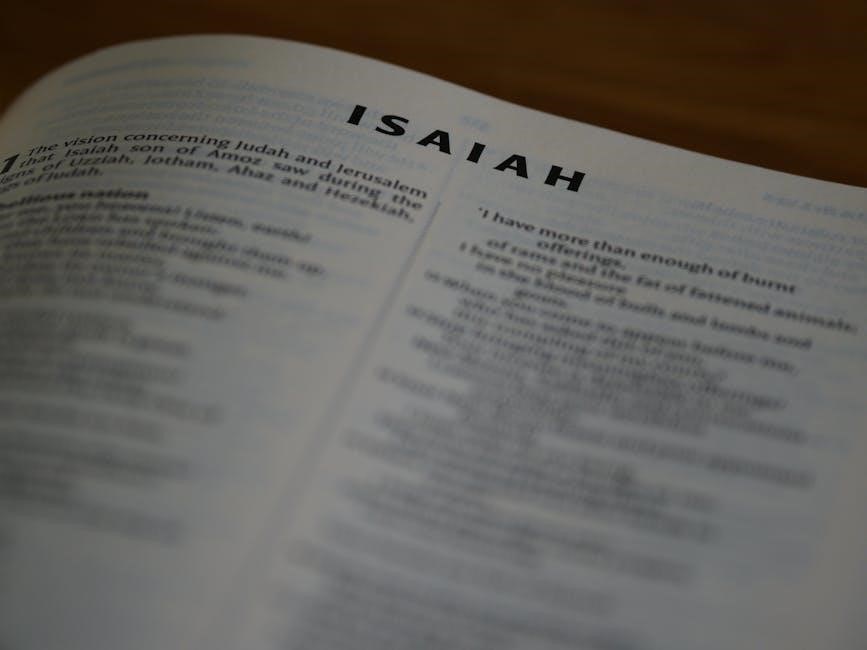
The Book of Isaiah is the longest prophetic book in the Old Testament‚ comprising 66 chapters. Authored by Isaiah‚ it is often called the “Bible in miniature” due to its structural similarity to the entire Bible‚ covering themes from creation to redemption. This foundational text profoundly influences the New Testament‚ with its rich theological insights and messianic prophecies.
Significance
The Book of Isaiah holds profound significance as the longest prophetic book in the Old Testament‚ comprising 66 chapters. It is often referred to as the “Bible in miniature” due to its structural resemblance to the entire Bible‚ encompassing themes from creation to redemption. Isaiah’s prophecies are deeply messianic‚ offering vivid descriptions of the Messiah and His mission‚ which are frequently referenced in the New Testament. Its literary beauty‚ theological depth‚ and historical relevance make it a cornerstone of both Jewish and Christian traditions‚ providing guidance on judgment‚ redemption‚ and God’s ultimate plan for humanity.
Bible in Miniature
The Book of Isaiah is often called the “Bible in miniature” due to its structural and thematic parallels with the entire Bible. Just as the Bible contains 66 books‚ Isaiah has 66 chapters‚ reflecting a microcosm of divine revelation. The first half (chapters 1-33) mirrors the Old Testament’s focus on law‚ judgment‚ and history‚ while the second half (chapters 34-66) aligns with the New Testament’s emphasis on grace‚ redemption‚ and the Messiah. This unique structure underscores Isaiah’s comprehensive vision of God’s plan‚ from creation to ultimate redemption‚ making it a quintessential summary of biblical theology.

Structure
The Book of Isaiah is divided into two main sections: chapters 1-39‚ focusing on judgment and warning‚ and chapters 40-66‚ emphasizing comfort and redemption.

Division
The Book of Isaiah is traditionally divided into two main sections: chapters 1-39 and 40-66. The first section focuses on judgment and warning to Judah and Israel‚ while the second emphasizes comfort and redemption. Within these sections‚ scholars identify further subdivisions‚ such as chapters 1-12 dealing with judgment‚ 13-27 addressing nations‚ and 28-35 focusing on redemption. Chapters 40-55 are known for the “Servant Songs‚” highlighting the Messiah’s role‚ while 56-66 address post-exilic restoration. This structure reflects Isaiah’s comprehensive vision‚ blending prophetic warnings with messianic hope.

Historical Context
The Book of Isaiah was written during a period of political turmoil and spiritual decline in Judah. Authored by the prophet Isaiah‚ it spans the reigns of King Uzziah to King Hezekiah‚ addressing issues like idolatry and social injustice. Composed in the 8th century BCE‚ the book reflects the Assyrian threat and the eventual fall of Jerusalem‚ offering a mix of warnings and hope for redemption. Its historical backdrop is crucial for understanding its prophetic messages.
Time and Place
The Book of Isaiah was written in the 8th century BCE‚ during the reigns of King Uzziah‚ Jotham‚ Ahaz‚ and Hezekiah of Judah. This period was marked by political turmoil‚ with the rise of the Assyrian Empire posing a significant threat to Judah. Isaiah’s ministry began around 740 BCE‚ shortly after King Uzziah’s death‚ and extended into the reign of King Hezekiah. The prophet’s visions and writings were influenced by the political and spiritual challenges of his time‚ including the invasion of Judah by Assyria and the widespread idolatry and social injustice prevalent among God’s people.
Key Events
The Book of Isaiah records pivotal events that shaped Judah’s history and spiritual landscape. A significant event was Isaiah’s call to prophecy in a vision of God enthroned in glory (Isaiah 6). The Assyrian invasion of Judah during King Hezekiah’s reign was another critical moment‚ with Isaiah urging faith in God over reliance on alliances. The fall of Jerusalem to the Babylonians‚ though occurring after Isaiah’s death‚ aligns with his prophecies of judgment and exile. These events underscore Isaiah’s dual themes of judgment and redemption‚ setting the stage for messianic hope and future restoration.

Theological Themes
The Book of Isaiah explores profound theological themes‚ including God’s sovereignty‚ redemption‚ and the Messiah’s role. It emphasizes judgment‚ grace‚ and the ultimate restoration of Israel and humanity.
Messianic Prophecies
The Book of Isaiah is renowned for its detailed Messianic prophecies. Isaiah foretells the Messiah’s birth‚ ministry‚ and sacrificial death. Notable passages include Isaiah 7:14‚ predicting a virgin-born Messiah‚ and Isaiah 53‚ describing His suffering and redemption. These prophecies are fulfilled in Jesus Christ‚ making Isaiah a cornerstone of Christian theology. The New Testament frequently references these passages‚ underscoring their significance. Isaiah’s vision of the Messiah as both suffering servant and reigning king provides a comprehensive view of His divine mission and purpose.
Judgment and Redemption

Isaiah emphasizes the dual themes of divine judgment and redemption. He warns of impending judgment for rebellion against God‚ as seen in Isaiah 2:2-4‚ where the Lord’s mountain is exalted above all others. Yet‚ amidst judgment‚ Isaiah offers hope of redemption through the Messiah. Isaiah 53 vividly portrays the suffering servant who bears the sins of many‚ symbolizing redemption through sacrifice. The book also highlights the ultimate redemption in the latter days‚ where God’s kingdom will reign peacefully. Isaiah’s prophecies intertwine judgment with the promise of restoration‚ reflecting God’s justice and mercy. His vision of redemption remains central to Christian and Jewish theology.

Literary Style
The Book of Isaiah exhibits a rich and poetic literary style‚ characterized by vivid imagery‚ metaphors‚ and parallelism. Isaiah’s use of language creates profound emotional and spiritual impact‚ making it a masterpiece of prophetic literature. His poetic devices‚ such as in Isaiah 2:2-4‚ paint a compelling vision of God’s future kingdom. The Servant Songs‚ like Isaiah 53‚ are particularly notable for their lyrical depth and theological significance. This literary brilliance enhances the book’s theological themes‚ making it a cornerstone of biblical study and inspiration.
Poetic Devices
The Book of Isaiah employs a wide array of poetic devices to convey its profound message. Imagery‚ metaphors‚ and parallelism are used extensively to paint vivid pictures of divine judgment and redemption. For instance‚ Isaiah 2:2-4 uses imagery of a mountain to symbolize God’s exalted presence. The Servant Songs‚ such as Isaiah 53‚ employ lyrical language to depict the Messiah’s suffering and triumph. These poetic techniques not only enhance the text’s literary beauty but also deepen its theological significance‚ making Isaiah’s prophecies both inspiring and intellectually engaging. The use of symbolic language adds layers of meaning‚ inviting readers to reflect deeply on its message.
Servant Songs
The Servant Songs in the Book of Isaiah are a series of poetic passages that describe a mysterious figure who suffers on behalf of others. Found in chapters 42‚ 49‚ 50‚ and 53‚ these songs depict the Servant’s mission of redemption‚ emphasizing humility‚ sacrifice‚ and divine purpose. Isaiah 53 is particularly notable for its vivid portrayal of the Servant’s suffering and ultimate triumph‚ often interpreted as a messianic prophecy. These passages are central to Christian theology‚ linking the Servant’s role to Jesus Christ. The songs’ literary artistry and theological depth make them a focal point for study and reflection.

New Testament Influence
The Book of Isaiah significantly influences the New Testament‚ with more citations from Isaiah than any other Old Testament prophet. Isaiah’s messianic prophecies‚ such as Isaiah 53‚ are fulfilled in Jesus Christ‚ validating His role as the Messiah and reinforcing the theological connection between the Old and New Testaments.
References
The Book of Isaiah is widely referenced in scholarly works and commentaries. Notable sources include the Bat Tsion Bible‚ which provides a detailed translation comparing Dead Sea Scrolls‚ Septuagint‚ and Peshitta. The Hebrew University Bible (1995) offers a critical edition of Isaiah‚ while The Digital Dead Sea Scrolls features digitized versions of ancient texts. Commentaries by authors like M.H. Goshen-Gottstein and John Oswalt are essential for deeper understanding. These resources are available in PDF formats online‚ including Isaiah Chapter 1 and The Book of Isaiah: Vol. I‚ ensuring accessible study materials for scholars and readers.

Downloadable Resources
PDF versions of the Book of Isaiah are available online‚ including Isaiah Chapter 1 and The Book of Isaiah: Vol. I. Additional resources like comprehensive commentaries and study guides are accessible for free download‚ offering in-depth analysis and historical context. These materials cater to both scholarly research and personal study‚ providing a wealth of information on Isaiah’s prophecies‚ theological themes‚ and literary style.
Sources
The Book of Isaiah is widely available in downloadable PDF formats‚ offering diverse editions and commentaries. The Bat Tsion Bible provides a modern translation with comparisons to ancient texts like the Dead Sea Scrolls. The Hebrew University Bible and editions from Magnes Press present scholarly analyses. Additionally‚ resources like Isaiah Chapter 1 and The Book of Isaiah: Vol. I are accessible for free. Commentaries by authors such as Oswalt and Soo J. Kim offer deep insights into eschatology and theological themes. These PDFs are ideal for both personal study and academic research‚ enhancing understanding of Isaiah’s visions and prophecies.
Study Guides
Study guides for the Book of Isaiah are readily available in PDF formats‚ offering comprehensive insights into its theological and historical context. Resources like Bible Study: The Book of the LORD in the End Times (Isaiah 34) provide detailed analyses‚ while Sealed By The King offers free PDF downloads for deeper exploration. These guides cover key themes such as messianic prophecies‚ judgment‚ and redemption‚ making them invaluable for both personal and group study. They often include commentary on Isaiah’s literary style and its influence on the New Testament‚ enriching readers’ understanding of this profound text.
The Book of Isaiah stands as a cornerstone of biblical prophecy‚ offering profound insights into God’s plan for humanity. Its 66 chapters encapsulate themes of judgment‚ redemption‚ and the coming Messiah‚ earning it the title of “Bible in miniature.” The book’s influence on the New Testament is unparalleled‚ with its prophecies shaping Christian theology. Available in various PDF formats‚ Isaiah’s teachings remain accessible for modern study‚ inviting readers to explore its timeless message of hope and salvation. This text continues to inspire faith and deepen understanding of God’s covenant with His people.